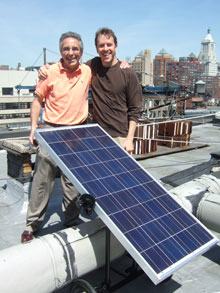 I don’t know if this is the most eco-correct solution (commenters feel free to weigh in), but I’m giving a borrowed solar panel a try to keep my laptop running after I snap off the circuit breaker to the apartment’s mains. To be precise, I’m using a SolarOne Harvester, an all-in-one unit that includes a panel, a battery and an inverter. As you all know, No Impact runs in stages and the no electricity stage begins on Saturday.
I don’t know if this is the most eco-correct solution (commenters feel free to weigh in), but I’m giving a borrowed solar panel a try to keep my laptop running after I snap off the circuit breaker to the apartment’s mains. To be precise, I’m using a SolarOne Harvester, an all-in-one unit that includes a panel, a battery and an inverter. As you all know, No Impact runs in stages and the no electricity stage begins on Saturday.
A lot of people suggested that, to run the blog and do my internet research, I should use public access computers at the library. That might be a good idea if, one, I didn’t have a computer already and, two, I didn’t spend several hours a day doing research. It doesn’t feel practical to me, given that I also have to bake the bread, stomp the laundry and find a little time to sing to Isabella.
Granted, there is definitely the impact of the manufacture of the solar panel, the battery it charges, and the inverter to supply AC. The good news is that the unit is borrowed from its manufacturer, SolarOne. It’s a floor model and will be returned to that use when I’m done with it in six months (that’s SolarOne’s President, Moneer Azzam, on my building’s roof with me in the photo).
It would not, by the way, have been a good choice to buy a new solar panel to use for the remaining six months of the No Impact experiment. A recent study shows that a rooftop solar panel system must run for about two years before it reaches the break even point in terms of generating more energy than it takes to manufacture it. A solar panel should last 20-25 years.
Oh, and in case you were wondering, the power from the Harvester will only be used for the laptop. We want to see what is like to live without a plethora of electric lights and whether we really do experience the second sleep phenomenon.
PS Mark your calendars! No Impact Man will be featured on both ABC’s Good Morning America and Nightline this coming Thursday, May 10.